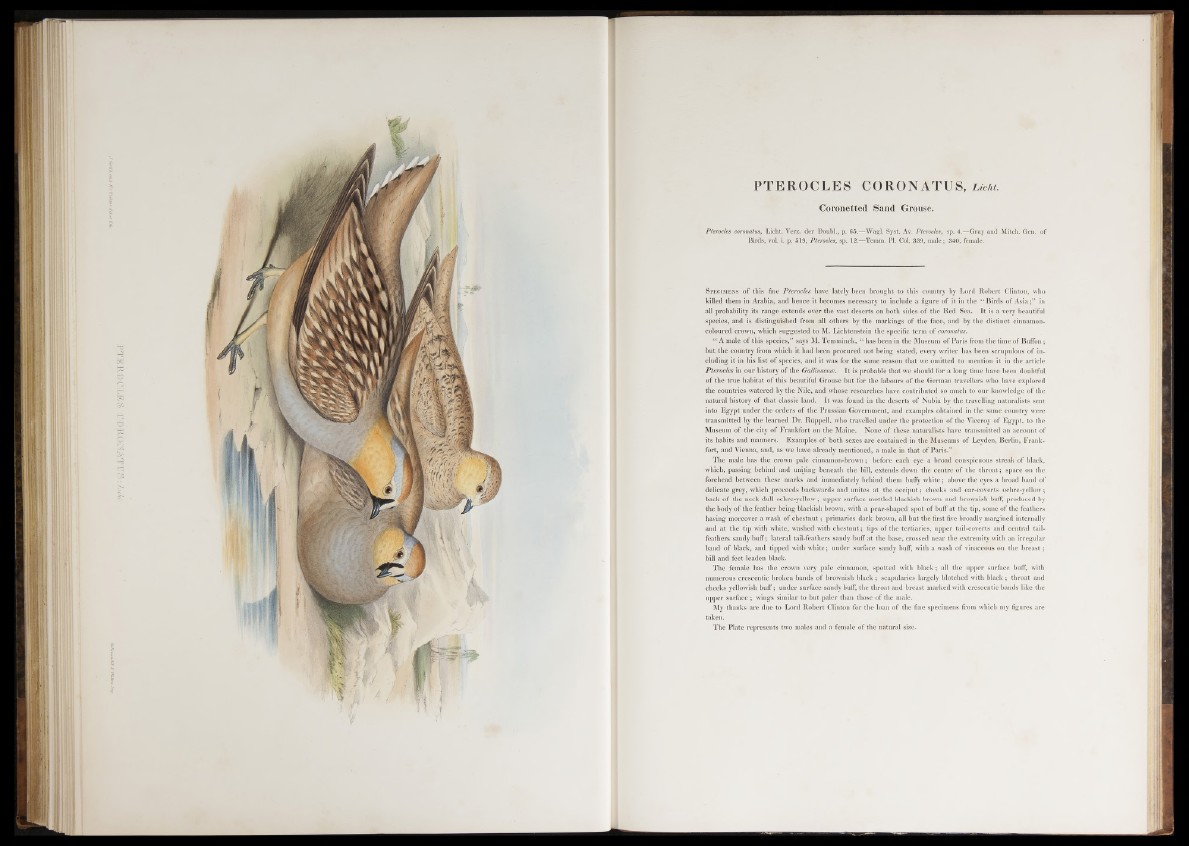
PTEROCLES CORONATUS, Licht.
Coronetted Sand Grouse.
Pterocles coronatus, Licht. Verz. der Doubl., p. 65.— Wagl. Syst. Av. Pterocles, sp. 4.—Gray and Mitch. Gen. of
Birds, vol. i. p. 519, Pterocles, sp. 12.— Temm. PI. Col. 339, male; 340, female.
S p e c im e n s o f this fine Pterocles have lately been brought to this country by Lord Robert Clinton, who
killed them in Arabia, and hence it becomes necessary to include a figure of it in the “ Birds of A sia;” in
all probability its range extends over the vast deserts on both sides of the Red Sea. It is a very beautiful
species, and is distinguished from all others by the markings of the face, and by the distinct cinnamon-
coloured crown, which suggested to M. Lichtenstein the specific term of coronatus.
“ A male of this species,” says M. Temminck, “ has been in the Museum of Paris from the time of Buffon;
but the country from which it had been procured not being stated, every writer has been scrupulous of including
it in his list o f species, and it was for the same reason that we omitted to mention it in the article
Pterocles in our history of the Gallinaceoe. It is probable that we should for a long time have been doubtful
of the true habitat of this beautiful Grouse but for the labours o f the German travellers who have explored
the countries watered by the Nile, and whose researches have contributed so much to our knowledge of the
natural history o f that classic land. It was found in the deserts o f Nubia by the travelling naturalists sent
into Egypt under the orders of the Prussian Government, and examples obtained in the same country were
transmitted by the learned Dr. Riippell, who travelled under the protection o f the Viceroy of Egypt, to the
Museum of the city of Frankfort on the Maine. None of these naturalists have transmitted an account of
its habits and manners. Examples o f both sexes are contained in the Museums of Leyden, Berlin, Frankfort,
and Vienna, and, as we have already mentioned, a male in that of Paris.”
The male has the crown pale cinnamon-brown; before each eye a broad conspicuous streak of black,
which, passing behind and uniting beneath the bill, extends down the centre of the throat; space on the
forehead between these marks and immediately behind them buify white; above the eyes a broad band of
delicate grey, which proceeds backwards and unites at the occiput; cheeks and ear-coverts ochre-yellow;
back of the neck dull ochre-yellow; upper surface mottled blackish brown and brownish buff, produced by
the body o f the feather being blackish brown, with a pear-shaped spot of buff at the tip, some o f the feathers
having moreover a wash of chestnut; primaries dark brown, all but the first five broadly margined internally
and at the tip with white, washed with chestnut ; tips o f the tertiaries, upper tail-coverts and central tailfeathers
sandy buff; lateral tail-feathers sandy buff at the base, crossed near the extremity with an irregular
band of black, and tipped with white; under surface sandy buff, with a wash o f vinaceous on the breast;
bill and feet leaden black.
The female has the crown very pale cinnamon, spotted with black; all the upper surface buff, with
numerous crescentic broken bands of brownish black ; scapularies largely blotched with black ; throat and
cheeks yellowish buff; under surface sandy buff, the throat and breast marked with crescentic bands like the
upper surface ; wings similar to but paler than those of the male.
My thanks are due to Lord Robert Clinton for the loan of the fine specimens from which my figures are
taken.
The Plate represents two males and a female of the natural size.